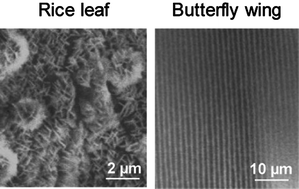Bioinspired rice leaf and butterfly wing surface structures combining shark skin and lotus effects
Abstract
Living nature is the inspiration for many innovations and continues to serve as an invaluable resource to solve technical challenges. We find that unique surface characteristics of rice leaves and butterfly wings combine the shark skin (anisotropic flow leading to low drag) and lotus (superhydrophobic and self-cleaning) effects, producing what we call here the rice and butterfly wing effect. A systematic study has been conducted with rice leaves and butterfly wings, using a combination of actual and replica samples. In order to mimic the rice and butterfly wing effect, replica rice leaf and shark skin samples received a superhydrophobic and low adhesion nanostructured coating. The data are compared to those of uncoated samples of fish scales and shark skin. Surface morphology characterization is conducted with


 Please wait while we load your content...
Please wait while we load your content...